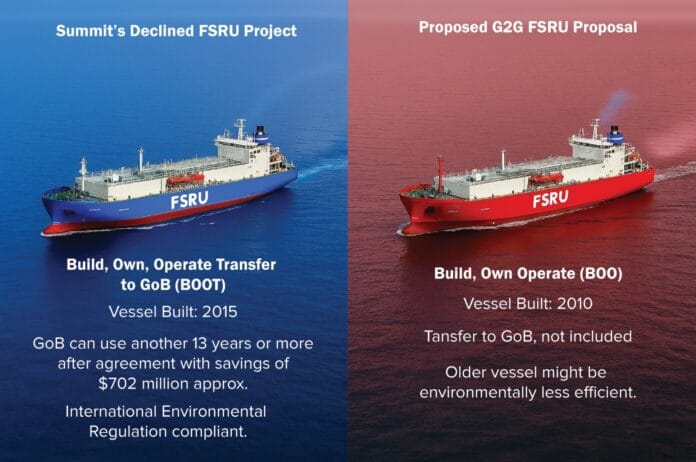The government is considering using a 2010-built Floating Storage and Regasification Unit (FSRU) instead of a 2015 model for its upcoming liquefied natural gas (LNG) project — a decision that could have far-reaching implications for cost, operational efficiency, and environmental performance.
According to official sources, Bangladesh currently operates two FSRUs under a Build-Own-Operate-Transfer (BOOT) model — the Moheshkhali LNG (MLNG) and Summit LNG (SLNG) terminals — both designed for a 13-year commercial operation period. If the new project adopts a 2010-built vessel, it would be around 18 years old at commissioning, significantly older than the existing units.
Lower initial cost but higher operational risks
Officials said one advantage of choosing a 2010-built FSRU is its lower acquisition or charter cost, which would reduce the project’s initial financial burden and potentially lower the regasification tariff.
However, experts warned that such savings could be offset by higher long-term costs. Older FSRUs are typically less fuel-efficient, have higher boil-off gas (BOG) losses, and require more frequent maintenance — raising the risk of supply disruptions to the national grid. This could adversely affect power generation, fertilizer production, and industrial output.
They also noted that a 2010-built vessel would have a shorter remaining operational life than a 2015-built one, necessitating earlier replacement or extensive refurbishment, which would increase lifecycle costs.
Environmental drawbacks
An older FSRU is also likely to be less environmentally efficient. The 2010 model may not comply with the latest International Maritime Organization (IMO) Tier III and MARPOL emission standards and could produce higher nitrogen oxide (NOx) and unburned methane emissions — known as “methane slip.”
Older vessels also rely on less efficient BOG management systems, such as forced burning or venting, leading to greater greenhouse gas emissions.
By contrast, a 2015-built FSRU would ensure lower emissions, improved fuel efficiency, and better compliance with future environmental regulations, making it a more sustainable choice for Bangladesh’s long-term energy goals.
BOO vs BOOT: weighing long-term benefits
The evaluation also compared the financial implications of the Build-Own-Operate (BOO) and Build-Own-Operate-Transfer (BOOT) models.
Under the BOO model, the government would incur lower upfront costs since ownership remains with the private operator. But experts cautioned that this model could lead to significant financial losses over time.
In contrast, under the BOOT arrangement, ownership of the FSRU transfers to the government after 15 years, allowing continued use for another 13 years or more. Given that FSRUs typically have a lifespan of about 40 years, this could save the government an estimated $702 million, assuming a daily charter rate of US150,000.
Long-term gain over short-term savings
Analysts concluded that while a 2010-built FSRU under a BOO model may appear more affordable initially, a 2015-built vessel under the BOOT model would offer better environmental performance, operational reliability, and long-term economic benefits.
In light of Bangladesh’s energy security and sustainability objectives, they said the newer FSRU model represents a more prudent investment for the country’s LNG infrastructure.
It is alleged that the government’s move to purchase the 2010 FSRU model is intended to favor a foreign company that has shown interest in supplying LNG to the country on a long-term basis.
What experts say
Energy expert Prof M Tamim told Just Energy News that the government should conduct a thorough cost-benefit analysis before finalizing the deal — whether through a government-to-government (G2G) arrangement or an open tender — and evaluate both the BOO and BOOT options carefully.
“In a hurried process, the country may face long-term challenges in LNG imports,” he cautioned.
Public policy expert M Masrur Reaz, chairman of the Policy Exchange, said setting up the FSRU under the BOO model would not best serve the country’s interests.
“Under the BOO arrangement, the government may save some money in the short term through a rental-based system, but this model does not ensure value or asset retention,” he said.
He expressed support for implementing the project under the BOOT model instead.
Energy and Mineral Resources Division Secretary Mohammad Saiful Islam said the government has decided to proceed with a 2010 FSRU model on a BOO basis considering its cost-effectiveness.
Since entering the global liquefied natural gas (LNG) market in 2018, Bangladesh has spent over $17.6 billion to import 31.61 million metric tonnes of LNG, amid declining domestic gas production and rising demand across industries, households, and the power sector, according to data from Rupantarita Prakritik Gas Company Ltd (RPGCL), a subsidiary of state-owned Petrobangla.
This year, the government had planned to import 108 LNG cargoes. That number is expected to rise to 115 cargoes next year.

